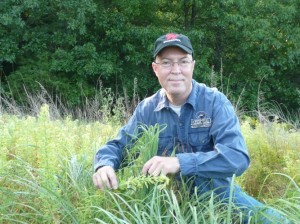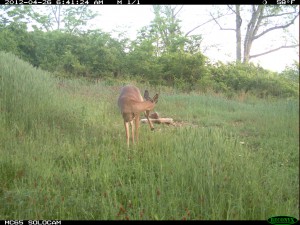Category: Whitetail Habitat Management
Ticks: On You and Your Deer
Summer 2012 may well be recorded as the summer of ticks! I use my Reconyx cameras year round to monitor and study deer at my place and on client properties. At my place near Branson, Missouri and a client’s property near Cadiz, Kentucky I’ve never noticed as many ticks on deer at this time of year during my 20+ year career of using trail cameras. The tick loads I’m seeing now are typically not seen until late summer.
The CDC (Centers for Disease Control) says, “Lyme disease is the most commonly reported vectorborne illness in the U.S. In 2009, it was the 5th most common Nationally Notifiable disease.”
Both Rocky Mountain Spotted Fever and Lyme’s are serious diseases. Those of us that are frequently in the outdoors need to be diligent about searching for and removing ticks after being in the field. The CDC Lyme Disease page has some useful information about how to prevent being bitten by ticks, how to remove ticks, and diagnosis of potential tick-borne diseases.
My family, staff, and, I are exposed to ticks almost daily. We’ve found that treating our clothes with Permanome and allowing it to dry on the clothes a few days before wearing works well. One treatment will last through the clothes being laundered several times. This spring while turkey hunting, Adam had treated his clothes and his brother didn’t. Adam said he literally watched ticks crawling on his brother and there were none on him. His brother hadn’t treated his clothes. Permanome is good stuff when used appropriately.
However, deer can only attempt to groom themselves and other deer to remove ticks. This is not effective based on my Reconyx images. In an effort to reduce the chances of my family and guests suffering from a tick-borne disease, and to improve the fawn survival and overall health of the deer herd at my place, I’m researching the cost and effectiveness of different tick control methods. If you follow GrowingDeer.tv at all, you know I use prescribed fire frequently. That’s clearly not controlling the tick population at my place. If you would like to reduce the number of ticks where you hunt, stay tuned.
Of all the predator control work I do, none may be more important than attempting to reduce the number of ticks to benefit the deer, turkey, and other game species using my place. From the comments on my Facebook page, ticks are a noticeable problem throughout much of the whitetails range this year. In many areas I’m sure there are more pounds of ticks per acre than there are predators – literally. I’ll keep you posted as to what I learn.
Growing Deer together,
Grant
Cheap Deer Hunting Land
Most hunters I know talk about finding cheap land for deer and turkey hunting! I do also. There is a way that many can gain acreage for literally a few hundred dollars per acre and some sweat equity! It is as simple as controlling noxious, invasive weeds.
Webster’s dictionary defines a weed as: a plant that is not valued where it is growing and is usually of vigorous growth; especially: one that tends to overgrow or choke out more desirable plants. Most hunters can only afford or have access to hunt land that is less than desirable. If weeds are taking up space on your hunting property, then it is much less expensive to kill those weeds and improve the habitat than to purchase additional acres!
Weeds that are common and very invasive throughout most of the whitetail’s range include:
- Sericea lespedeza
- Johnsongrass
- Honey locust trees
- Knapweed
- Kudzu
There are many more species of invasive weeds that rob literally millions of acres of productivity from wildlife habitat.
The good news is that most of these weeds can be controlled by using a selective herbicide. A selective herbicide is one that only kills specific species. With some research, usually a herbicide that will kill the targeted weeds and not harm the beneficial species can be found. Although this research may seem daunting, I frequently use Crop Data Management Systems free website to research which herbicides to use for specific weeds.
The site can be searched by simply going to the Services and then Labels tabs. Then use simple search for the name of the herbicide to research, or use the advanced search option and search on specific herbicides and the crop you wish to protect.
For example, sericea lespedeza has invaded some of the bedding and native vegetation areas at The Proving Grounds. It doesn’t provide quality forage or cover for wildlife. It is literally decreasing the functional size of my hunting property. Some quick research pointed toward the herbicide PastureGard. However, I wanted specific information to know if PastureGard would control serecia lespedeza and if so, how to apply the herbicide. I searched the CDMS website for the PastureGard label and quickly confirmed it was a good choice to kill serecia lespedeza, how much herbicide to apply, and any personal safety precautions. The image at the top of this blog was taken this morning. I’m thrilled to see the serecia dying and the sparse big bluestem undamaged by the herbicide. I had confidence that would happen after reading the herbicide label.
Controlling weeds is a very important part of wildlife habitat management. Using the correct herbicide, if that’s the best method, saves the manager money and time and returns acres to productive habitat. I’m all about getting more hunting land for not much money and some sweat equity.
Growing Deer together,
Grant
Timber Management
I’m in the Montgomery, Alabama airport waiting on a flight home. I’ve been working in a privately owned property in south Alabama that is leased to a hunting club. The current tenants have established 100+ acres of food plots, completed an intensive camera survey of the deer herd, and are keeping great harvest records. They are off to a great start!! However, there is much more to deer management than food plots and estimating the demographics of the herd. The property is approximately 2,000 acres. Therefore the food plots only compose approximately five percent of the property. The remaining 95% is just as important for the deer management and hunting programs!!
To address this point, I spent time with the landowner touring the property and addressing the most obvious habitat features that are very unproductive from a wildlife and timber production point of view. In the south, this usually means unmanaged or poorly managed timber stands.
Unfortunately, unproductive timber is common on privately owned forested properties. Forestry practices in the past often dictate the current forest health unless the past forest was totally removed as part of the regeneration program. Typically, the best trees are harvested on private land and the diseased and/or poorly formed trees are left. In any business, if the best stock is removed and the less desirable is left behind for several generations the overall quality decreases substantially. In forestry, this is called high–grading.
Deer herd management always means some degree (usually more than less) of habitat management. Healthy forests usually result in healthy deer. What makes a healthy forest for deer and other species of wildlife? There should be some sunshine reaching the forest floor. There shouldn’t be weedy species, such as sweetgum, filling all the space where more desirable species have been harvested.
Remember that the ax can be one of the best deer management tools – or one of the worst, depending on how and when it is used. It’s always best to use all the tools in the deer management tool box, not just the tractor and a bag of seed. For the deer herd to express its full potential, the entire habitat must be managed, not just a small percentage.
Growing Deer together,
Grant




